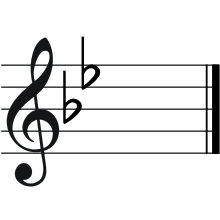Mozart and G minor
 | |
| Relative key | B♭ major |
|---|---|
| Parallel key | G major |
| Dominant key | D minor |
| Subdominant | C minor |
| Component pitches | |
| G, A, B♭, C, D, E♭, F, G | |
G minor has been considered the key through which Wolfgang Amadeus Mozart best expressed sadness and tragedy,[1] and many of his minor key works are in G minor. Though Mozart touched on various minor keys in his symphonies, G minor is the only minor key he used as a main key for his numbered symphonies. In the Classical period, symphonies in G minor almost always used four horns, two in G and two in B-flat alto.[2] Another convention of G minor symphonies observed in Mozart's No. 25 and No. 40 was the choice of the subdominant of the relative key (B♭ major), E♭ major, for the slow movement; other non-Mozart examples of this practice include J.C. Bach Opus 6 No. 6 from 1769, Haydn's No. 39 (1768/9) and Johann Baptist Wanhal's G minor symphony sometime before 1771 (Bryan Gm1).[3] Isolated sections in this key within Mozart's compositions may also evoke an atmosphere of grand tragedy, one example being the stormy G minor middle section to the otherwise serene B-flat major slow movement in the Piano Concerto No. 20.
List of works
Here is a list of works and movements by Mozart in G minor:
- Andante from Symphony No. 5, K. 22
- Fugue in G minor, K. 154 (385k) (Organ)
- Symphony No. 25, K. 183/173db
- "Vorrei punirti indegno" from La finta giardiniera, K. 196
- "Agnus Dei" from Missa Brevis No. 9, K. 275/272b
- Allegro in G minor, K. 312/590d
- 6 Variations in G minor on "Helas, j'ai perdu mon amant", K. 360 (violin and piano)
- Fugue in G minor, K. 401/375e (Organ)
- Andante from Piano Concerto No. 18, K. 456
- Der Zauberer, K. 472
- Piano Quartet No. 1, K. 478
- String Quintet in G minor, K. 516
- Symphony No. 40, K. 550
- "Ach, ich fühl's" from The Magic Flute, K. 620
See also
References
- ↑ Hellmut Federhofer, foreword to the Bärenreiter Urtext of Mozart's Piano Quartet in G minor. "G-Moll war für Mozart zeitlebens die Schicksaltonart, die ihm für den Ausdruck des Schmerzes und der Tragik am geeignetsten erschien." ("G minor was, for Mozart, the most suitable fate-key throughout his life for the expression of pain and tragedy.")(
- ↑ H. C. Robbins Landon, Mozart and Vienna. New York: Schirmer Books (1991): 48. "Writing for four horns was a regular part of the Sturm und Drang G minor equipment." Robbins Landon also notes that Mozart's No. 40 was first intended to have four horns.
- ↑ James Hepokoski og Warren Darcy, Elements of Sonata Theory (Oxford University Press: 2006) p. 328